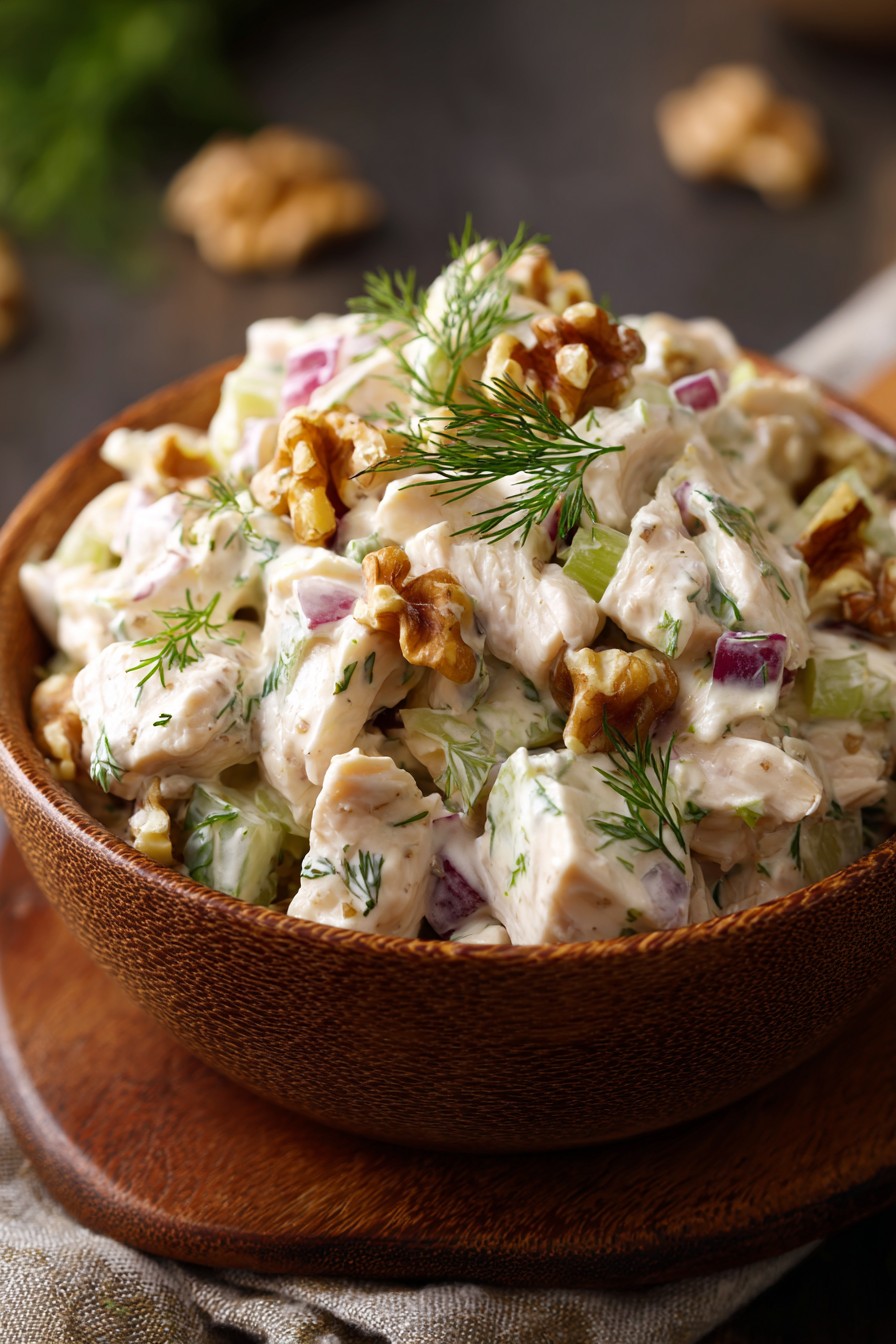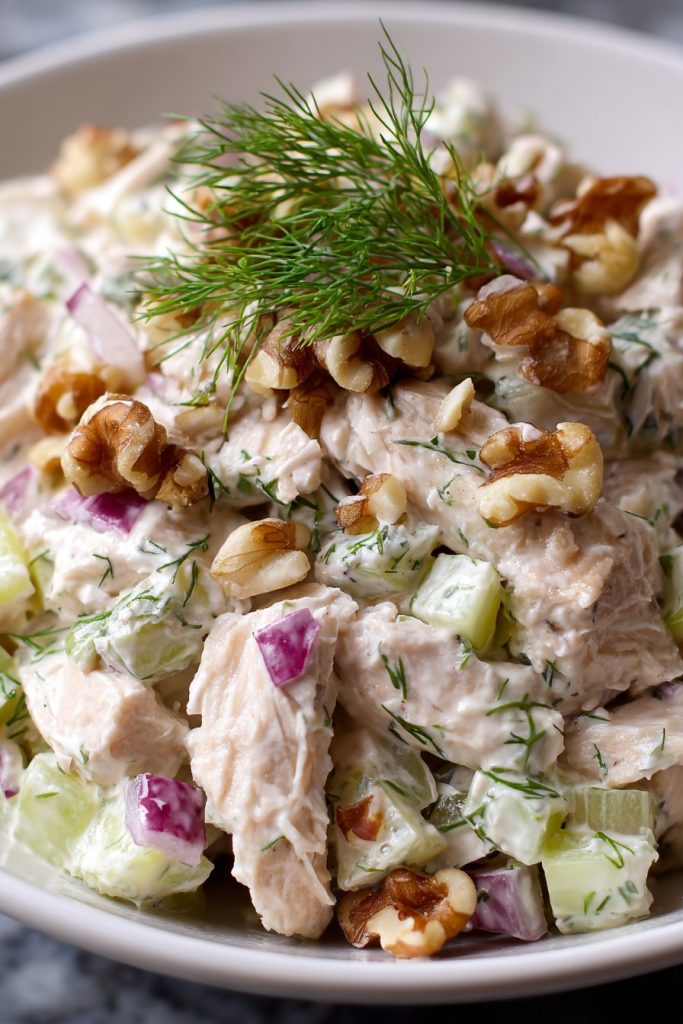Just when you thought chicken salad couldn’t get any better, this classic recipe proves that simplicity often wins the flavor game. Join me as we transform humble ingredients into the most crave-worthy lunch or dinner staple you’ll make all week!
Why This Recipe Works
- The combination of both mayonnaise and Greek yogurt creates a creamy yet tangy dressing that clings perfectly to every ingredient without being overly heavy or greasy.
- Using a mix of shredded and diced chicken provides varied textures that make each bite interesting, while the celery and red onion add crucial crunch and brightness.
- Resting the salad for at least 30 minutes allows the flavors to meld beautifully, transforming simple ingredients into something truly magical and cohesive.
- The balance of fresh dill, Dijon mustard, and lemon juice cuts through the richness of the dressing, creating layers of flavor that keep you coming back for more.
- This recipe is incredibly versatile—it works equally well as a sandwich filling, salad topper, or eaten straight from the bowl with crackers for maximum enjoyment.
Ingredients
- 2 cups cooked chicken breast, shredded and cooled
- 1/2 cup mayonnaise
- 1/4 cup plain Greek yogurt
- 2 celery stalks, finely diced
- 1/4 cup red onion, minced
- 2 tablespoons fresh dill, chopped
- 1 tablespoon Dijon mustard
- 1 tablespoon lemon juice
- 1/2 teaspoon garlic powder
- 1/4 teaspoon black pepper
- 1/2 teaspoon salt
- 1/4 cup chopped walnuts (optional)
Equipment Needed
- Large mixing bowl
- Cutting board
- Chef’s knife
- Measuring cups and spoons
- Mixing spoon or spatula
- Food processor (optional for quick chopping)
Instructions

Prepare Your Ingredients
Start by ensuring your cooked chicken breast is completely cooled—this is crucial because warm chicken will make your salad watery and cause the mayonnaise to separate. If you’re cooking chicken specifically for this recipe, poach two boneless, skinless chicken breasts in simmering water for 15-18 minutes until they reach an internal temperature of 165°F, then let them cool completely before handling. Meanwhile, wash and finely dice your celery stalks, making sure to include some of the lighter inner leaves for extra flavor. Mince the red onion into tiny pieces—you want just enough to provide flavor without overwhelming bites. Chop your fresh dill, measuring out two tablespoons packed, and have all other ingredients measured and ready to go. This mise en place approach makes the mixing process smooth and ensures you don’t forget any components.
Combine the Dressing Base
In your large mixing bowl, combine the mayonnaise and Greek yogurt, whisking them together until completely smooth and homogeneous. The Greek yogurt not only adds tanginess but also boosts the protein content while cutting some of the fat from the mayonnaise. Add the Dijon mustard, lemon juice, garlic powder, black pepper, and salt, whisking vigorously for about 30 seconds until everything is fully incorporated and the mixture appears slightly thickened. Taste the dressing at this stage and adjust seasoning if needed—remember the chicken will absorb some saltiness. If you prefer a thinner consistency, you can add another tablespoon of lemon juice or a teaspoon of water. This is also the time to add any other dried herbs or spices you might enjoy, such as paprika or celery seed.
Mix in Chicken and Vegetables
Add your cooled, shredded chicken to the dressing mixture, using a spatula to fold it in gently but thoroughly. Make sure every piece of chicken gets coated with the dressing—this is where the magic starts happening! Next, add the finely diced celery and minced red onion, continuing to fold everything together until evenly distributed. The vegetables should be visible throughout but well-integrated. If you’re using walnuts or any other crunchy elements, hold off on adding them until the end to maintain their texture. At this point, your salad should look creamy but still have plenty of visible chunks and texture variations. Avoid overmixing, which can break down the chicken too much and make the salad mushy.
Incorporate Fresh Herbs and Final Touches
Sprinkle the freshly chopped dill over the mixture and gently fold it in until evenly distributed. The dill should be bright green and visible throughout the salad, providing little bursts of fresh flavor in every bite. If you’re adding walnuts or other nuts, now is the time to incorporate them—toasting them first in a dry skillet over medium heat for 3-5 minutes until fragrant will enhance their flavor dramatically. Give the entire mixture one final gentle fold to ensure everything is perfectly combined without crushing the ingredients. The salad should look well-dressed but not soupy—if it seems too dry, you can add another tablespoon of mayonnaise mixed with a teaspoon of lemon juice.
Chill and Serve
Cover the bowl tightly with plastic wrap or transfer the chicken salad to an airtight container. Refrigerate for at least 30 minutes—though ideally 2 hours—to allow the flavors to meld and develop. During this chilling time, the chicken will absorb the dressing flavors while the vegetables will soften slightly and release their juices into the mixture. When ready to serve, give the salad one quick stir to redistribute any dressing that may have settled. Serve chilled on bread, crackers, over greens, or enjoy it straight from the bowl! Properly stored in the refrigerator, this chicken salad will keep beautifully for 3-4 days, making it perfect for meal prep.
Tips and Tricks
For the absolute best chicken salad, consider poaching your own chicken rather than using rotisserie or canned chicken. To poach, place two boneless, skinless chicken breasts in a saucepan and cover with cold water by about an inch. Add a quartered onion, a chopped celery stalk, a bay leaf, and a teaspoon of whole peppercorns. Bring to a gentle simmer over medium heat—never a rolling boil—and cook for 15-18 minutes until the internal temperature reaches 165°F. Remove from heat and let the chicken cool in the poaching liquid for 30 minutes—this keeps it incredibly moist and flavorful. When shredding, use two forks or your hands for a rustic texture, or pulse briefly in a food processor for a finer consistency. If you’re short on time, high-quality canned chicken (packed in water, not oil) can work in a pinch, but be sure to drain it thoroughly and pat it dry with paper towels to prevent a watery salad. For maximum flavor development, consider making the salad a day ahead—the overnight rest allows the ingredients to marry beautifully. If you find your salad too dry after chilling, you can revive it with a tablespoon of mayonnaise mixed with a teaspoon of lemon juice. Conversely, if it becomes too wet, drain any excess liquid or add a handful of crushed crackers or breadcrumbs to absorb moisture. Always taste and adjust seasoning after chilling, as cold temperatures dull flavors—you might need an extra pinch of salt or squeeze of lemon juice. For food safety, never leave chicken salad at room temperature for more than two hours, and always use clean utensils when serving to prevent contamination.
Recipe Variations
- Curry Chicken Salad: Add 1-2 teaspoons of curry powder to the dressing mixture, along with 1/4 cup of golden raisins and 2 tablespoons of sliced almonds. The warm spices complement the chicken beautifully, while the raisins add sweetness and the almonds provide crunch. This variation is perfect for sandwiches or served with naan bread.
- Apple Walnut Chicken Salad: Fold in 1/2 cup of finely diced crisp apple (such as Granny Smith or Honeycrisp) and 1/3 cup of chopped toasted walnuts. The apple adds refreshing sweetness and crunch that balances the savory elements perfectly. A teaspoon of honey in the dressing enhances this variation wonderfully.
- Greek-Inspired Chicken Salad: Replace the dill with 2 tablespoons of fresh oregano, add 1/4 cup of crumbled feta cheese, and include 2 tablespoons of chopped Kalamata olives. Use all Greek yogurt instead of mayonnaise for a lighter version, and add a pinch of dried oregano for extra Mediterranean flair.
- BBQ Chicken Salad: Mix 2 tablespoons of your favorite BBQ sauce into the dressing, and add 1/4 cup of cooked corn kernels and 2 tablespoons of chopped scallions. This smoky, sweet variation is fantastic served on toasted buns or with tortilla chips for dipping.
- Cranberry Pecan Chicken Salad: Incorporate 1/3 cup of dried cranberries and 1/4 cup of chopped toasted pecans. The tart-sweet cranberries and rich pecans create a festive flavor profile that’s perfect for holiday gatherings or special occasions.
Frequently Asked Questions
Can I use canned chicken for this recipe?
Absolutely! While freshly cooked chicken provides the best texture and flavor, high-quality canned chicken (packed in water, not oil) can work well when you’re short on time. Be sure to drain it thoroughly and pat it dry with paper towels to remove excess moisture, which would otherwise make your salad watery. I recommend using two 10-ounce cans for this recipe—look for brands with minimal additives. The texture will be slightly softer than fresh chicken, but the flavor will still be delicious. For best results, consider flaking the canned chicken with a fork rather than mashing it, and maybe add an extra crunch element like additional celery or some chopped apples.
How long does chicken salad last in the refrigerator?
Properly stored in an airtight container, this chicken salad will keep beautifully for 3-4 days in the refrigerator. The acidity from the lemon juice and the salt content help preserve it, but because it contains mayonnaise and dairy (from the Greek yogurt), I wouldn’t recommend keeping it longer than four days. Always use clean utensils when serving to prevent contamination, and never leave it at room temperature for more than two hours. If you’re meal prepping, consider storing the dressing separately and combining it with the chicken and vegetables the day you plan to eat it for the freshest texture and flavor.
Can I make this recipe dairy-free?
Yes, absolutely! To make this recipe dairy-free, simply replace the Greek yogurt with an additional 1/4 cup of mayonnaise or use a dairy-free yogurt alternative. Look for unsweetened, plain varieties of coconut or almond milk yogurt that have a similar tanginess to Greek yogurt. You might need to adjust the lemon juice slightly to achieve the right acidity balance. All other ingredients in the basic recipe are naturally dairy-free, so this simple substitution will work perfectly. Just be sure to check your mayonnaise brand—some contain dairy derivatives, so opt for a certified dairy-free version if needed.
What’s the best way to serve chicken salad?
Chicken salad is incredibly versatile! Classic serving options include between two slices of bread (toasted whole wheat or sourdough work beautifully), in a croissant for a special treat, or in lettuce cups for a low-carb option. It’s also fantastic served on crackers, as a topping for green salads, or even as a dip with vegetable sticks. For a heartier meal, stuff it into a tomato or avocado half, or use it as a filling for wraps with some fresh spinach leaves. Personally, I love it simply eaten with a fork straight from the bowl—no judgment here!
Can I freeze chicken salad?
I don’t recommend freezing chicken salad, as the mayonnaise-based dressing will separate and become watery when thawed, resulting in an unappetizing texture. The vegetables (especially celery) will also become mushy, and the overall quality will significantly decline. Chicken salad is best enjoyed fresh or refrigerated for a few days. If you need to make ahead, you can freeze cooked, plain chicken and then prepare the salad fresh when needed. Alternatively, you can mix all the dry ingredients and freeze them, then prepare the dressing fresh and combine when ready to eat.
Summary
This basic chicken salad recipe delivers perfect creamy texture, balanced flavors, and endless versatility. With simple ingredients and easy techniques, it’s a foolproof staple that will become your go-to for quick lunches, elegant entertaining, or satisfying snacks. Happy cooking!
Basic Chicken Salad
6
servings15
minutesIngredients
Instructions
- 1 Prepare all ingredients—ensure chicken is cooled, vegetables are diced, and herbs are chopped.
- 2 In a large bowl, whisk together mayonnaise, Greek yogurt, Dijon mustard, lemon juice, and spices until smooth.
- 3 Add shredded chicken to dressing and fold gently until evenly coated.
- 4 Incorporate diced celery, minced onion, and fresh dill, mixing until well distributed.
- 5 Add walnuts if using, then cover and refrigerate for at least 30 minutes before serving.



